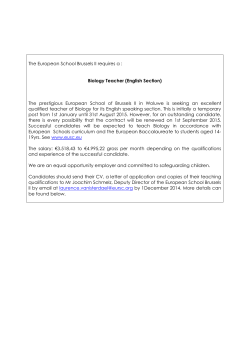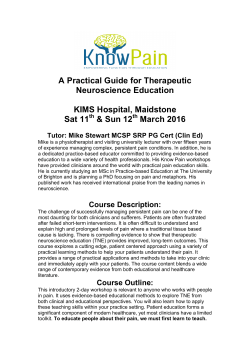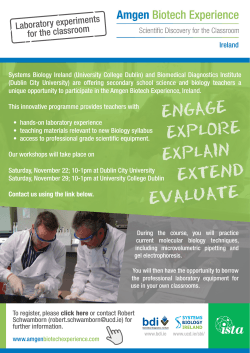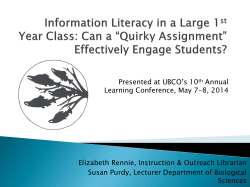
Document
Magazine R1147 Q&A Nick Strausfeld Nicholas J. Strausfeld was born in Surrey and raised in Brighton, Sussex. He received his B. Sc. and Ph.D. from University College London (1965, 1968) and his German Habilitation from the University of Frankfurt. After 19 years in Germany, first at Frankfurt’s Zoology Institute, later the MPI Tübingen and EMBL Heidelberg, he was appointed full professor in 1987 in the Division of Neurobiology at the University of Arizona. His identification of neurons mediating motion detection and comparative studies of the insect brain led to a John Simon Guggenheim Memorial Foundation Fellowship in 1994, followed by a MacArthur Foundation ‘Genius’ Fellowship in 1995. He was elected a Fellow of the Royal Society of London in 2002. His current research focuses on brain evolution. What turned you on to biology in the first place? My fascination with plants began in early childhood, exploring my mother’s extraordinarily creative garden. An interest in proper science started when I attended a junior school in Brighton. There, a courtly spinster found fulfillment in instructing unruly eight- and nine-year-olds in the rudiments of biology, taking a chosen few on long country rambles, from which we returned greatly disheveled, clutching paper bags stuffed with berries and leaves, old bird nests, a skull or two of a rabbit or, if really lucky, one that belonged to a badger. Those adventures were the roots of my later decision to opt for science rather than the classics, much to the disapproval of the masters in what the British obtusely call Public School. But, I was lousy at languages anyway. And what drew you to neuroscience? My training in neuroscience and neuroanatomy began serendipitously, in the Zoology Department at University College London. Students were better off then because each was well known to a department’s entire faculty. David Blest who was a young lecturer at UCL, and had done his postgraduate training with Niko Tinbergen in Oxford, took me on as his Ph.D. student to study motionsensitive neurons he and Tom Collett had discovered in moths, using what today would be laughably primitive methods for recording unit activity. I lacked the patience to spend hours in the dark poking sharpened needles into moth brains and had little aptitude for electronics. So when David’s colleague Brian Boycott suggested I tried using Golgi methods for staining single neurons, that basically settled matters. Neuroanatomical research provided almost instant gratification because each newly sectioned brain held a brand new collection of neurons to sort out. When I took my Ph.D. in 1968, being the first neuroanatomist since 1915 to have published neuroanatomy on the insect visual system, I suddenly had the ticket for postgraduate research in Germany funded by the Alexander von Humboldt Foundation, and then shortly afterwards a position at a MaxPlank Institute, where I stayed until 1975. You are a neuroscientist, but you now publish papers on evolution. How is that? The view once conveyed was that a biologist should, within sensible limits, be prepared to eat the animal that she or he was researching. I first heard this at a meeting where Bill Kristan publicly consumed a very alive medicinal leech, one of those he used at UCSD for his research. As were many others, I was quite impressed. This encouraging notion provided yet another impulse to expand my horizon beyond blowfly vision and to have a go at crustaceans, which were far more appetizing. One thing led to another: comparative brain anatomy morphed into using brain architectures for cladistic analyses and for resolving phylogenetic relationships across all the arthropods. This research is tremendous fun but it doesn’t exactly appeal to agencies holding the purse strings, at least not in the US where the word ‘evolution’ scares some people rigid. Some years ago, I eventually did get to eat my original experimental animal. My wife Camilla and I were in France, when a power failure required us to eat our dinner by candle light. Not being able to see much, I hadn’t noticed that the piece of rather ripe (and delicious) Saint Nectaire I’d just placed in my mouth hosted a vigorous colony of blowfly larvae. There really was no alternative: I swallowed the lot. If you had to choose a different field of biology, what would it be? Paleontology. It is an unusual Photo: Camilla Strausfeld pursuit: one that combines a lot of very hard work, such as collecting in the field or rummaging through museum collections, with the skills of interpreting structures in a functional and taxonomic context. Since 2012, I have been working on fossil nervous systems belonging to stem arthropods, the remains of which occur in the Chengjiang (and probably other) Lagerstätten in southwest China. These Lower Cambrian taxa are aesthetically pleasing and at the same time tremendously challenging with regard to interpreting the organization and identities of their appendages, exoskeleton and preserved organ systems. That they require meticulous observation and illustration satisfies the artist in me. Will your pursuits in this area of research displace others? I don’t know yet. One of the pleasures of being a scientist of a certain age is that I have the freedom to do stuff that is tangential, though related, to ‘bread-and-butter research’. Being a neuroanatomist by trade, the study of minutiae has prepared me for work of another kind, which is interpreting delicate structures preserved in rock. And my early education in zoology serves me well for evolutionary studies. Changing direction requires some intense self-education. But that is what a scientist’s life — hopefully any life — should always be: autodidactic. Otherwise the brain falls apart. Having said that, I will also continue my work on arthropod visual systems for a few years yet. Current Biology Vol 24 No 24 R1148 What about retirement? The same question was asked recently by one of my university administrators. I told her that she should keep a sharp eye out for a long wooden box being carried out of the neuroscience department; then her question will have been answered. But, I hope to be fit enough to continue for a few years yet before I bow out. Who were your key early influences? First and foremost my parents: my father was an artist who had fled Hitler’s Germany. He didn’t have much time for authoritarians. Nor was it easy for an artist with a German name to earn a living in Britain after the war, although it got much better after about 1965. He was a wonderful and liberal man who instilled in me a certain rebelliousness. My mother was also an artist. Her medium was the loom. Hence my early visual experience of wefts and warps, patterns, shapes and colors, which must have done wonders for the development of my visual cortex. My college tutors taught me a modicum of intellectual selfconfidence — enough required to survive an ecology in which creativity was the key selector. My advisors at University College London were unusual people who nurtured their students’ youthful and oftentimes crass rejection of the pecking order. I credit two of those advisors, David Blest and Brian Boycott, with the successful beginning of my scientific career. The degree of freedom they encouraged was tremendously useful later on in navigating, as a complete outsider, a stultifying German academic system that finally dissipated in the late 1970s. Do you have scientific heroes? How can one pick only a few, when there are so many to choose from? But yes, if forced to identify any then Charles Darwin and Caroline Herschel are two. The first needs no explanation. The second epitomizes tenacity, loyalty and courage at a time when women rarely participated in scientific discovery. Her story, which is very moving, is described in Richard Holmes’s prodigious book The Age of Wonder. Another is Félix Dujardin, a 19th century French polymath, founder of helminthology as well as the first student of insect brains, about whom I wrote in my book Arthropod Brains. Two others whom I greatly admire are Sydney Brenner and Seymour Benzer, both for their wisdom and subtle humor as much as for their science. Do you have a favourite paper or science book? I have just mentioned one. Darwin’s the Descent of Man is another, with its focus on sexual selection and Darwin’s explicit claim for our species’ ancestry along with his repudiation of divine creation. For an understanding of Darwin, the man, Janet Browne’s two-volume biography Voyaging and The Power of Place is spellbinding. It’s not just the biography as such, her use of language is a joy. How does biology education need to change? Nations’ Bills of Rights, or their equivalents, need amendment now to insist that one preeminent right and responsibility of mankind is having a planet worth living on. And that can be achieved only if every child, teenager and young adult has to study ecology and evolution. National programs of public lectures would help, like those promoted by T.H. Huxley to the working public in the late 1800s. Then maybe, just maybe, we may be able to survive the next 100 years, though it doesn’t look too good right now. The resistance to such teachings by certain religious factions makes the future much darker. What’s the best thing about being a scientist today? It should be, but is often not, the freedom to explore. There aren’t many unknown places left to which a human can travel, except by using proxies — robots or telescopes — which are marvels but can’t take us anywhere physically. So what is left? The exploration by our brains of natural phenomena both past and present. And what are the biggest problems for biological sciences today? First, research funding, take neuroscience as an example: in the US, and many other countries, funding agencies are buying into an entity comparable to one that Eisenhower warned against in the 1960s. Similar to his ‘militaryindustrial complex’, we today have a biomedical-industrial complex that views neuroscience research as an anthropocentric enterprise. This is reflected in the National Institutes of Health’s accelerated withdrawal from basic research. A symptom of this state of affairs is the intellectually bereft moniker, the ‘model organism’. This is no criticism of those working on those species, but I feel sorry for young adventurous minds that are deflected from exploring other animals. Apart from everything else, the focus on ‘model organisms’ is inimical to deep scholarship. And the second? The second problem concerns public awareness about what science is telling us about our planet’s immediate future. The diminution of basic research funding directly leads to public ignorance. Instead of being regaled by news of scientific advances and debates, the public is fed palliatives advertising the triumph of modern technology in pharmaceutics and medicine along with (bogus) news about industrialized ‘greening’ of the environment. Would funding agencies provide the funds, they could do immense good by generating information about what is happening to our planet. Take the fishing industries, for example. I learned recently from someone who has seen the evidence first hand that trawlers are scouring the sea beds bare — entire biotopes are being irreversibly destroyed, the consequences of which don’t bear thinking about. Instead of funding studies on the phenomena of global warming, when the data are already in and we know what’s happening, that money could be better spent on funding public education about how we might stop this madness and find strategies for sustainable natural ecologies that can feed us. But, I fear it’s all too late. If not a scientist, what would you have become? I would be what I intended to be when I was sixteen: a forester. I have always delighted in the sounds and smells of a forest, the cycle of the seasons, the nostalgia of autumn when the paths are thick with fallen leaves and fungi are everywhere. The sheer physical labor of maintaining a healthy woodland I find most attractive for a fulfilled life. Planted forests speak to the ability of us humans to plan for the long term — something that has become almost alien to us. Putting saplings into the soil, knowing that one’s great-great grandchildren will be the first to reap the benefit of that action should be a lesson to us all that we need to envision the future, not of tomorrow but of 100, 150 years hence. University of Arizona, Tucson, USA. E-mail: flybrain@email.arizona.edu
© Copyright 2025





















